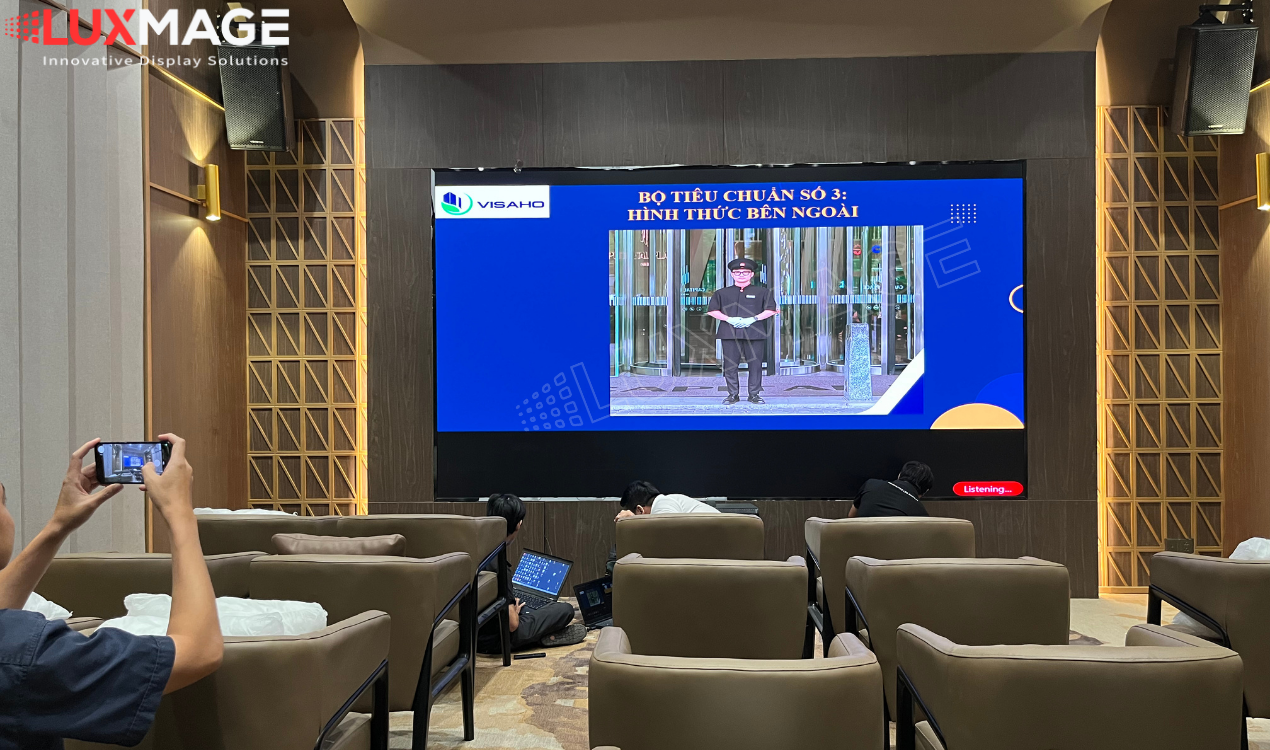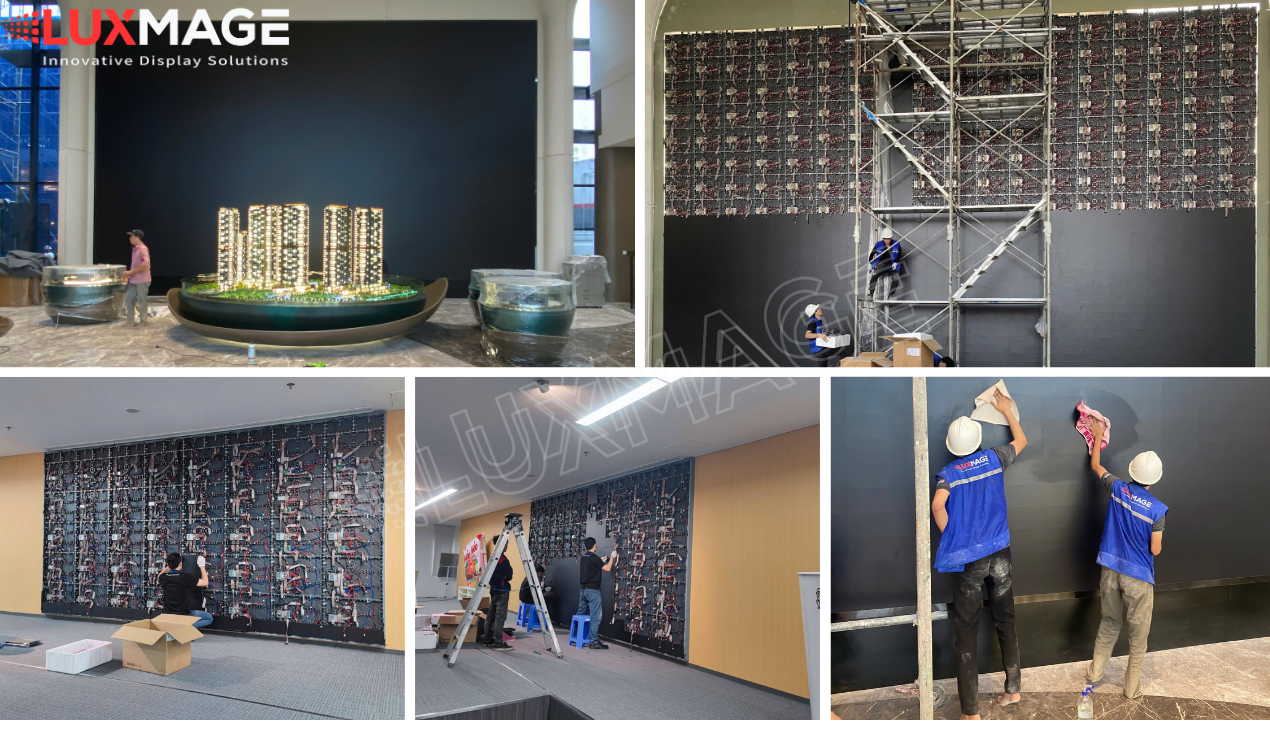In large conference rooms, traditional display solutions such as projectors often produce blurry, blurred images under ambient light, while LCD/OLED screens are limited by size and distracting border edges. This directly affects the efficiency of data transmission and information fairness for attendees sitting at different angles. To completely overcome these problems, LED conference room screens have emerged as the new standard. In this article, Luxmage will delve into the three core elements that LED screens bring, helping them surpass all other display solutions: Improve Image Quality, Optimize Sharpness, and Expand Viewing Angle for all attendees, no matter where they are in the large conference room.
LED screens are called Emissive Display technology because they emit light from individual diodes (LEDs), instead of using a backlight like LCDs. This operating mechanism is the key to the superior image quality and sharpness.
1. Superior Brightness and Anti-Glare Advantages
Brightness is the first and most obvious factor when comparing LED screens with projectors. Projectors require an ideally dark environment to achieve acceptable contrast, but this is rarely the case in modern meeting rooms where natural light and overhead lighting are required to maintain alertness and note-taking.
Meeting room LED screens easily achieve high brightness, often maintaining at 1000 nits or more , and can even exceed 1500 nits. This powerful brightness allows the screen to completely "defeat" ambient light. The displayed images will always be clear, with vivid colors even under harsh sunlight shining into the room. The practical benefit is that businesses no longer have to worry about pulling the curtains or turning off the lights, thereby promoting a more open, dynamic and effective meeting environment.
Flexible brightness adjustment (via ambient light sensor) is also a big plus, helping the screen automatically reduce brightness when the room is dark, protecting the viewer's eyes and optimizing power consumption.
.png)
2. Absolute Black Contrast
Contrast Ratio is a measure of the difference between the brightest white and the darkest black that a screen can produce. It determines the depth of an image and the clarity of detail.
In an LED display, each light-emitting diode is an independent light source. This means that when a pixel needs to display black, that LED can be turned off completely . This mechanism creates a near-infinite contrast ratio, which is not possible with backlit display technology.
Enhanced Reality: Creating absolute black helps clearly separate details in dark areas of images, videos, or complex graphs. Text outlines, fine details in technical drawings or financial charts will be sharper, not blending together. This true color and image depth makes it easier for viewers to analyze data, especially important in design meetings, medical meetings, or in-depth data analysis.
See detailed information to understand better here: Meeting Room LED Screen - Modern Display Solution With COB Technology
1. The Decisive Role of Pixel Pitch (P) in the Boardroom
In LED technology, sharpness depends not only on the overall resolution (e.g. Full HD, 4K) but also on a more important index: Pixel Pitch (P) . Pixel Pitch is the physical distance (measured in millimeters - mm) between the centers of two adjacent pixels.
In large conference room environments , viewers are often seated very close to the screen (viewing distance can be as little as 3 meters). If the P is too large, viewers will easily see individual pixels (also known as "cracking" or "graining"). This breaks the continuity of the image.

2. Choose Small P for Superior Sharpness
For meeting rooms, experts recommend using LEDs with small Pixel Pitch (usually P2.5 or less, ideally P1.5 or P1.25).
The smaller P , the greater the pixel density per unit area (e.g., 1 square meter).
Improvement: Images, text, and graphics will appear as smooth and seamless as when viewed on a conventional LCD screen, but at a much larger size. This smoothness is crucial when presenting long documents, Excel spreadsheets, or finely detailed graphics. The small P LED screen removes the barrier of close viewing distance, allowing the presenter to stand close to the screen without detracting from the viewing experience.
3. Formula for Determining Ideal P (Optimal Viewing Distance)
To achieve optimal sharpness and avoid pixel binning, engineers often apply the following formula: $P le D / 2000$ Where: $D$ is the closest viewing distance (in mm).
For example, if the nearest viewer is sitting 3 meters (3000mm) away from the screen, the ideal Pixel Pitch should be $3000 text{mm} / 2000 = 1.5 text{mm}$ (ie P1.5). Consulting and installing the correct Pixel Pitch according to the room size is key to ensuring customers receive the best display quality.
See detailed information to understand better here: What is a Meeting Room LED Screen | Everything Businesses Need to Know Before Choosing
.png)
The current LED display market is dominated by two main technologies: SMD LEDs and Chip-on-Board (COB) LEDs. Choosing between the two depends on budget, durability, and desired level of sharpness.
SMD is the most common technology, in which LED chips are packaged into small clusters and then glued to the surface of a PCB board.
Advantage:
COB is an advanced technology where LED chips are mounted directly onto a circuit board, then protected with a layer of epoxy or resin.
Outstanding Advantages:
(1).png)
Businesses can flexibly advise customers: SMD for cost efficiency and good quality , and COB for the ultimate experience in durability and sharpness .
In a large conference room, the effectiveness of the display is not only judged by those sitting in the center, but by all attendees. The ability to expand the viewing angle of the LED display is a key factor to ensure information fairness.
1. Optimal Light Direction Design of LED Diode
LED displays, especially high-quality SMD and COB modules, are designed to disperse light at a wide angle. Manufacturers have optimized the structure of the LED diodes and the housing to achieve horizontal and vertical viewing angles of up to 160° or 170° .
This wide angle view makes a lot of sense in a large conference room:
Maintain Brightness: When viewed from an angle, the brightness of the LED display decreases very little compared to when viewed straight on.
Color Preservation: More importantly, color and contrast are maintained almost uniformly. Red charts remain red, and blue text remains saturated, without turning gray or yellow like some older technologies.
2. Fix the "Off-Axis Color Shift" Problem
Older display technologies like LCDs often suffer from "Off-Axis Color Shift" - colors shift or invert when viewed from a large angle. This is annoying and can lead to miscommunication.
LED conference room screens completely eliminate this problem. Thanks to their self-illumination and uniform light dispersion, everyone sitting along the conference room wall can still follow the presentation content with near-perfect image quality. This uniformity in color and brightness is a huge advantage, especially when decisions require absolute color accuracy, such as in meetings about branding, advertising or product design.
(1).png)
1. Optimize the Experience for All Attendees
In a large conference room with a capacity of 50-100 people, the front row and the back row can be dozens of meters apart. Ensuring everyone has a good viewing experience is the responsibility of the display system.
2. Support Effective Interaction and Exchange
When everyone can clearly see the content, it's easier for them to interact and exchange ideas. The clarity of images facilitates:
Online Meeting: When the meeting room is used for Video Conferencing, the large and sharp LED screen ensures that the remote partner's face is displayed in true size and quality, creating a feeling of closeness like being in a face-to-face meeting.
Multi- Window Display: The large LED screen can be divided into multiple windows (Multi-Window) to display video calls, Excel reports, and PowerPoint presentations at the same time. Wide viewing angle ensures clarity for all content displayed simultaneously.
(1).png)
Once you understand the superior advantages of Image Quality, Sharpness, and Viewing Angle that LED displays bring, the next step is to choose the right implementation partner. Working with a professional supplier like Luxmage ensures that your project is not just about purchasing equipment, but also owning a comprehensive, customized display solution and dedicated technical support.
Luxmage is committed to providing both of the most advanced LED technology lines on the market to meet all customer needs and budgets:
We understand that every business's meeting room is unique. Luxmage does not sell pre-packaged products but provides in-depth technical consulting services:

Choosing an LED screen is a long-term investment. Luxmage ensures the value of your investment through:
Switching to LED screens is a necessary step to maintain a competitive advantage in the digital business environment. Choosing Luxmage means choosing a trusted partner who not only provides technology but also professionalism and commitment, helping your LED screen system become the most effective tool in every business decision.
Contact us at:
Vi Luc Technology Company Limited - LUXMAGE
Address: 63 Lo Lu, Truong Thanh, Thu Duc, HCMC
Hotline: 0988.895.066 - 093.333.5066
Email: sale@luxmage.com
Hot news
Posted by: Admin - Date: 20-11-2025
Last Page: Outdoor LED Signage Display | A Solution to Optimize Customer Experience and Boost Revenue
- IMMERSIVE Showroom System | Advanced Visual Display Solutions for Enterprises & Real Estate
- Applications of Curved LED Displays in Shopping Malls, Events, Showrooms, and Studios
